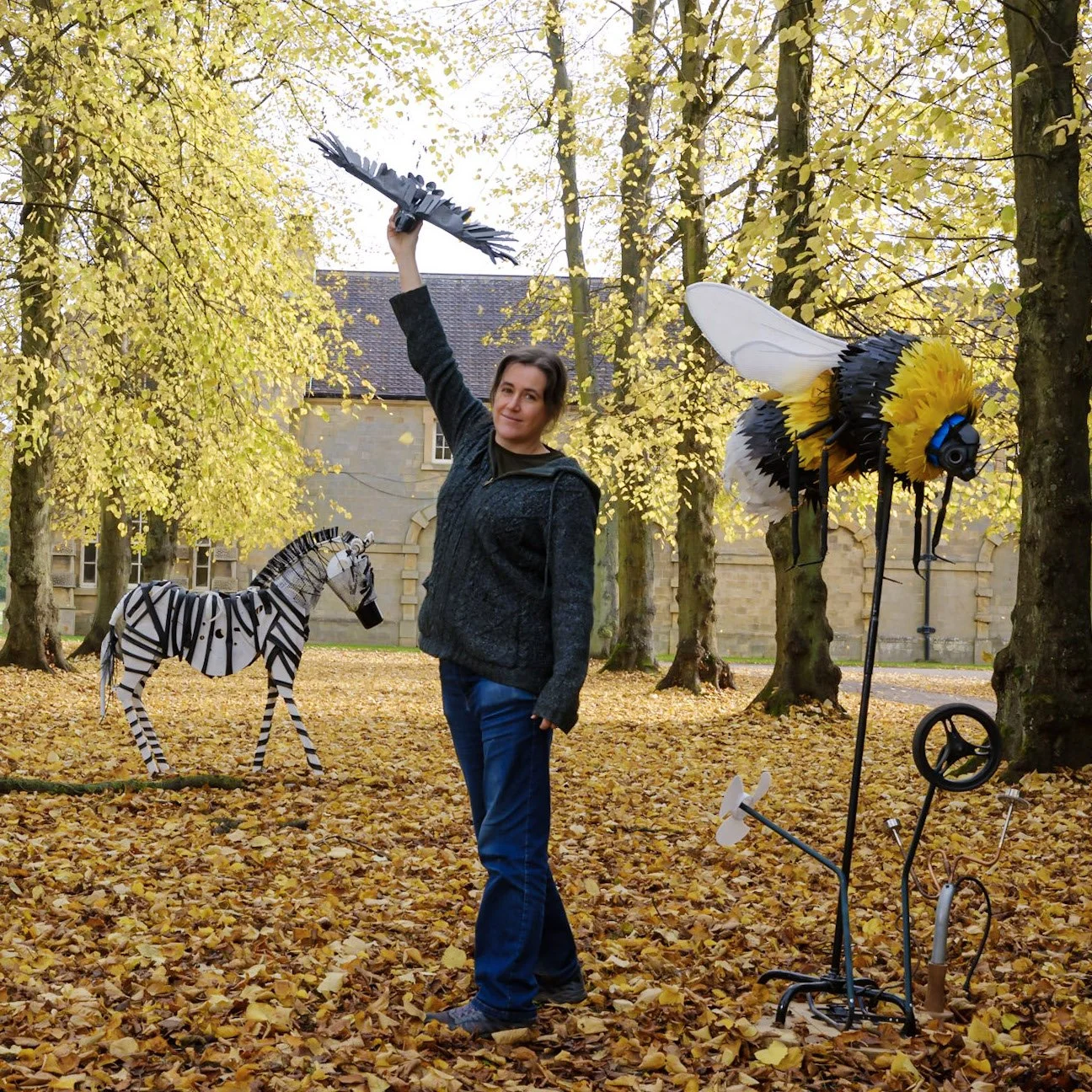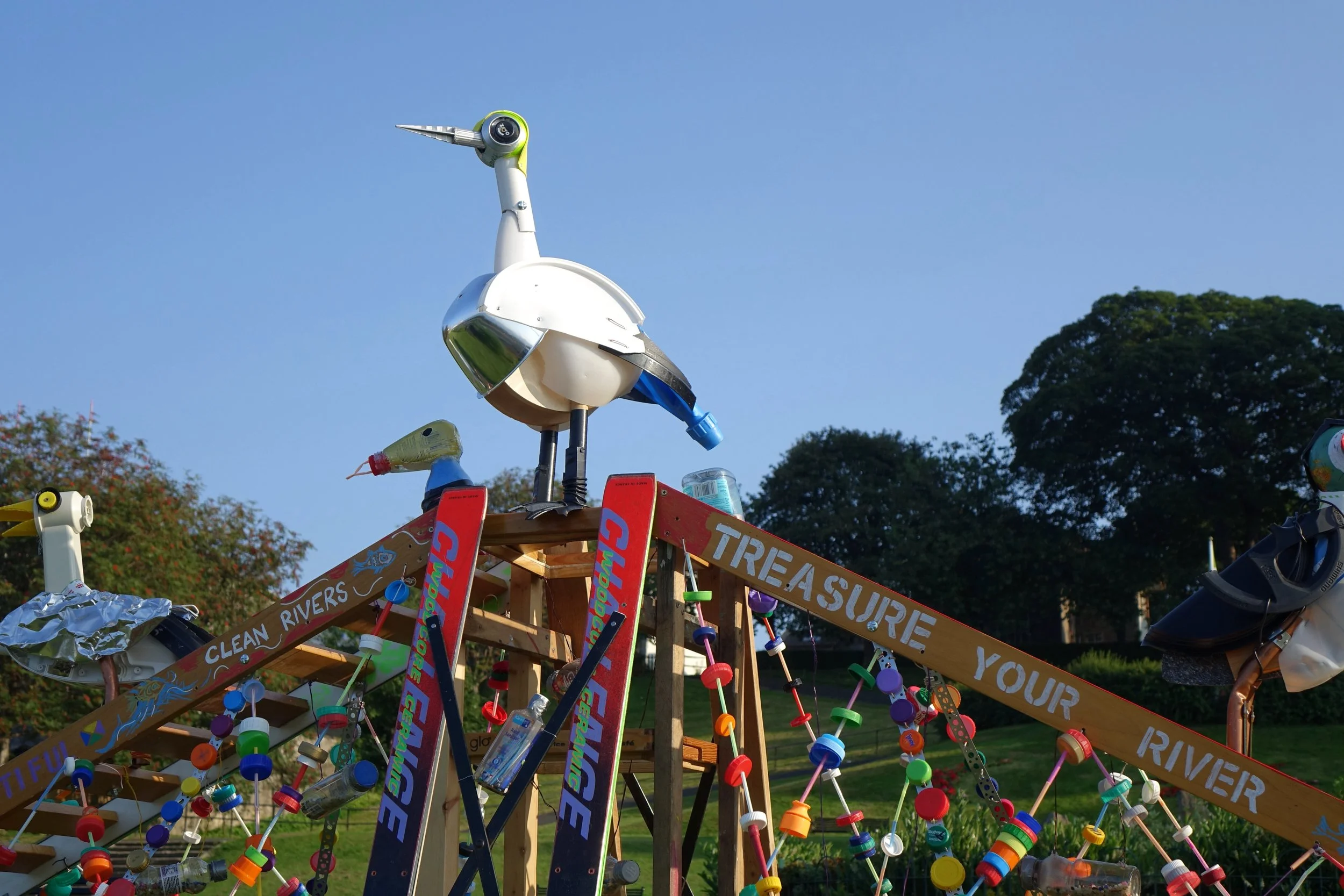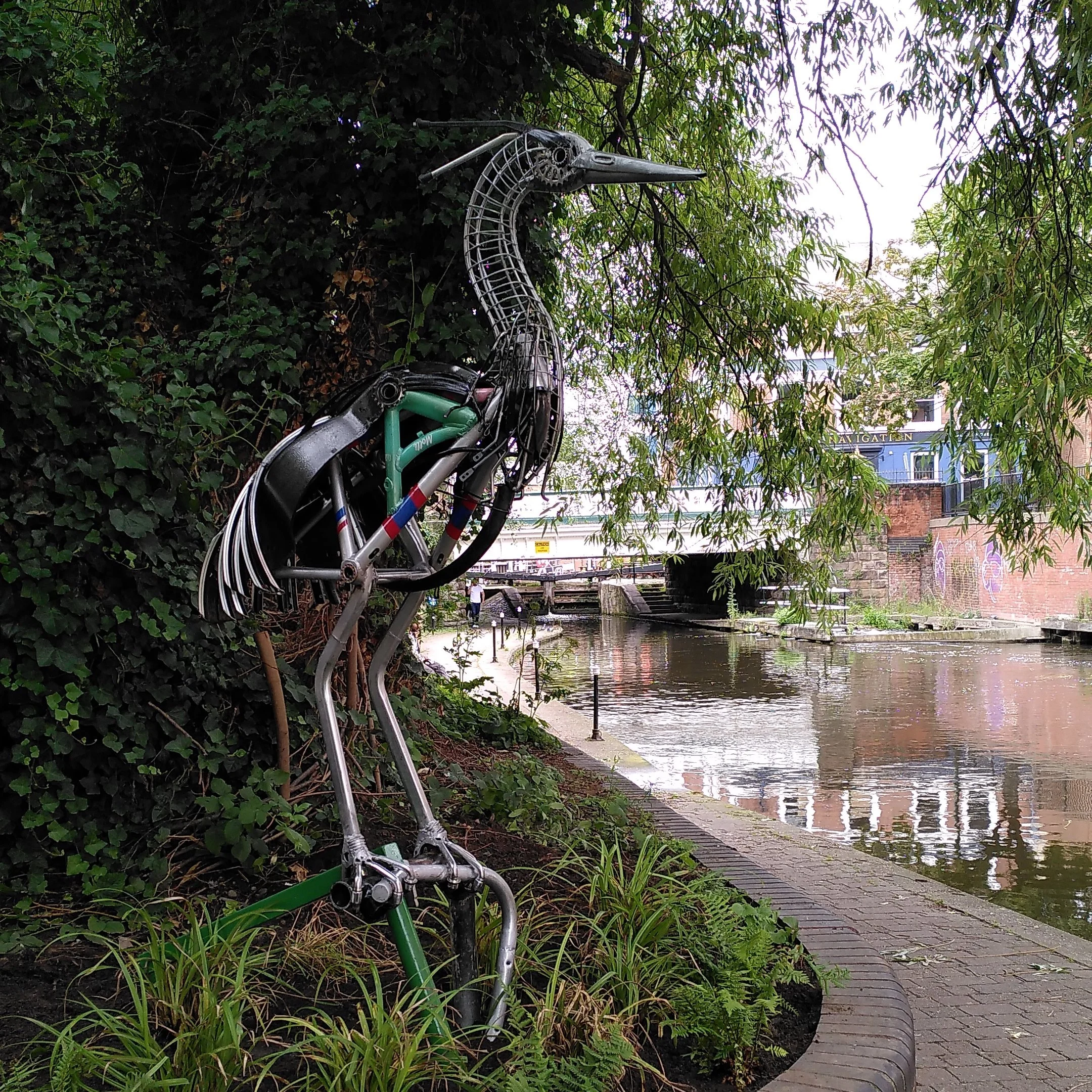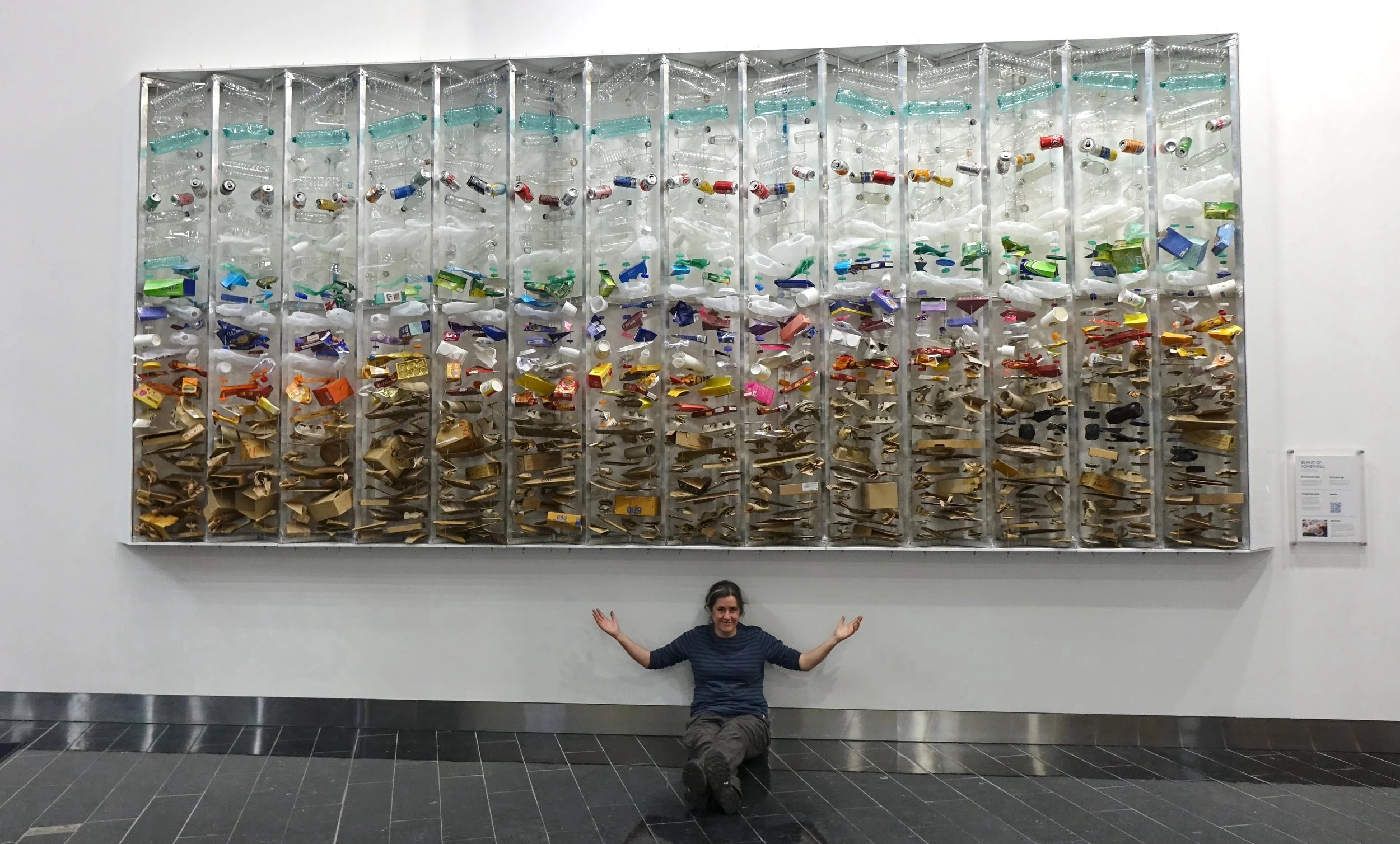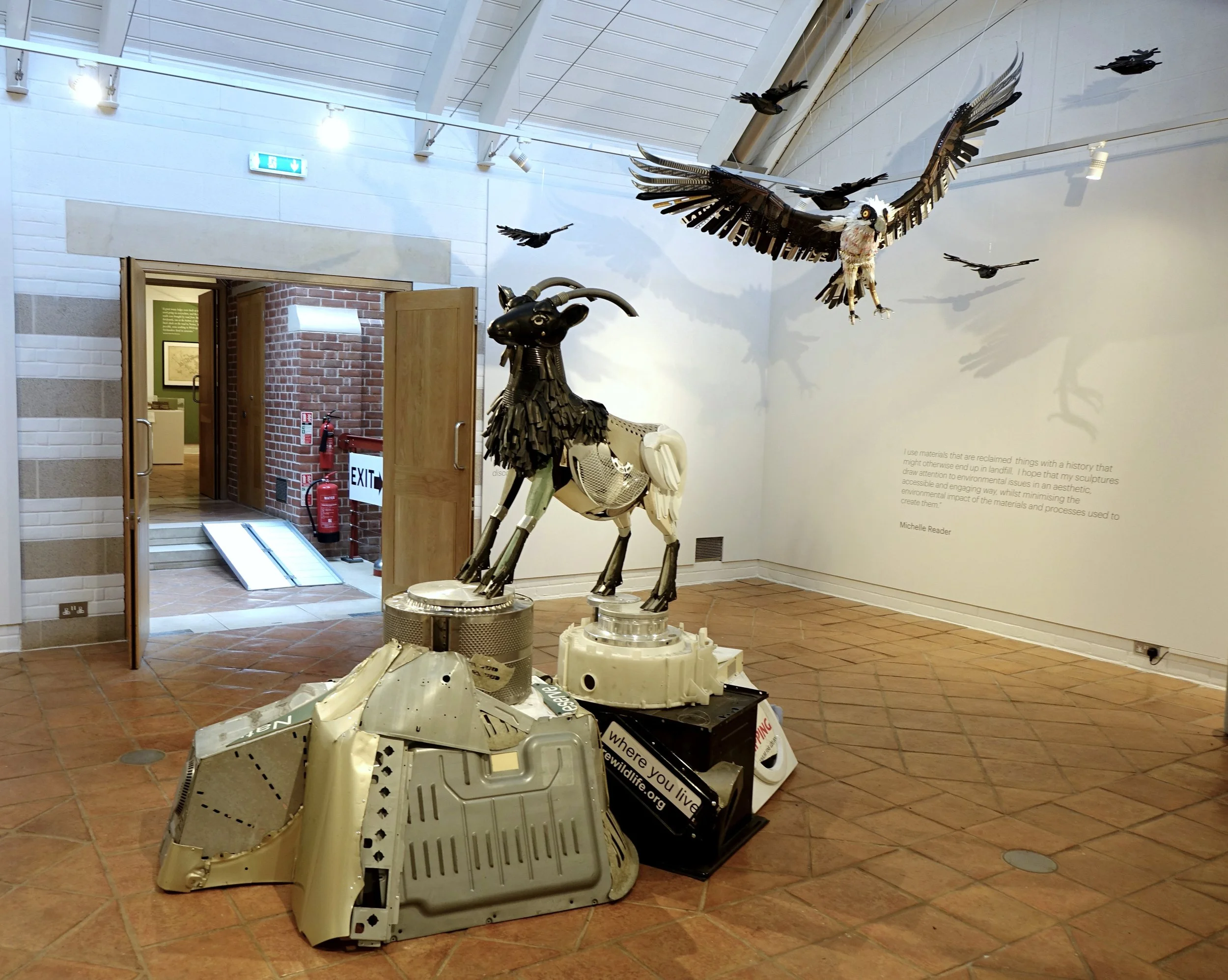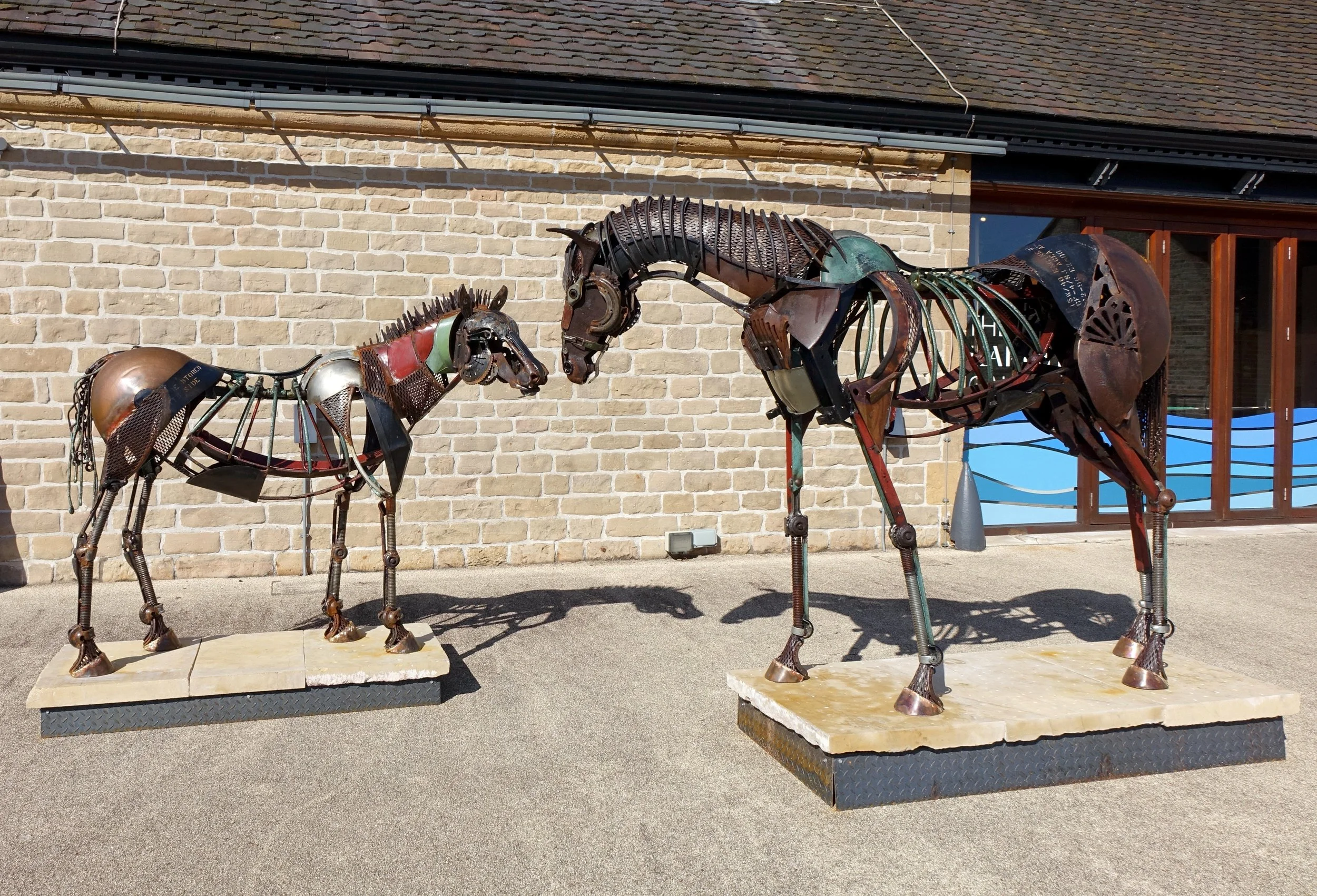Michelle Reader -
Making Art from Waste Materials
Interview with Michelle Reader, written by Andy Barrett
Michelle Reader has been making art from waste materials since 1997. Working from a studio with the Harley Foundation at Welbeck her work often comments on issues of waste and environmental degradation. We met to talk about her practice; of the types of waste she works with; the sculptures and other pieces she has created from them; and her relationship with the waste industry.
Can you start by telling me a little about where this way of working originated from?
I suppose there were three main reasons. When I was doing my Fine Art degree at DMU, I really enjoyed playing around with found objects and using the shapes and textures and colours of things I’d found to create with. I liked the playfulness of that, the joy of combining things to see what you might end up with. The second thing is that as a new graduate I was short on funds and it’s a very cheap way to work rather than buying expensive
resources I could continue with this idea and way of working; it made sense financially. But most importantly it was an environmental reason, of not using materials which are toxic, like resin, (or which have an impact on the planet) and of minimising the use of virgin materials from non-renewable sources. I joined Greenpeace as a teenager and was very conscious about the environment. And through that the work increasingly began to engage with ideas around reclaimed materials and of the positive impact of this. So quite often my work is linked to campaigns about resources and waste.
When I was starting out, I used to get a lot more work with local authorities at a time when they had money to do things like this; such as promoting kerbside recycling schemes. It was very much about recycling at that point, whereas now there’s more awareness of the need to reduce consumption, along with ideas of circularity. The message was much more basic then, and we’re further forward now in the way we conceive of materials that can be used again and again.
I used to be involved with the Remarkable Recycling Gala when I first moved to Nottingham, when it was held in Sherwood as part of Sherwood Art Week, before moving to Middle Street Resource Centre in Beeston. It was an annual event where makers who created their products from found materials would come together. That hasn’t restarted since the pandemic.
(The idea of the circular economy is to create a system where materials never become waste, with both products and materials being kept in circulation through processes like maintenance, reuse, refurbishment, remanufacture, recycling, and composting. In doing so economic activity can engage with the challenge of the consumption of finite resources. There are many short films available that explain this idea, such as this one from the Ellen MacArthur Foundation.)
What kind of materials do you work with?
I work with all sorts of waste; whether that be household waste like plastic bottles, cardboard, and coffee cups, or forms of industrial waste. Ideally the materials that I use are connected to the issue that the project wants to focus on, and sourced on site or from the client’s own waste stream. So, for instance, I did an environmental project with a company called Hubbub who were working on a campaign around five cities called Treasure Your River. It was aiming to raise awareness about how litter and rubbish often finds its way into rivers and then into the oceans; and that it’s helpful to think about this, that just because litter is dropped in one place, such as a street in the middle of a city or a local park, it doesn’t mean that it will simply stay there.
In each city I worked with a different community group and we created an installation that was relevant to that site from the kinds of waste materials that were being littered. In Edinburgh we made a structure of the Forth Bridge with seabirds on it, in Starbank Park overlooking the Forth of Firth. A group of schoolchildren who came to help brought along nurdles they had collected on the shoreline, which had probably blown into the sea from a nearby manufacturing facility, or been spilled from a lorry or shipping container. The structure of the bridge was made from bits of old furniture, and the gannets and puffin made from plastic bottles and other packaging materials and household waste. The youngest children visiting the park threaded bottle lids on to the electrical cables which crisscrossed the structure. In Cardiff we made a seagull sitting on top of a treasure chest overflowing with plastic bottle ‘water’ and with sea creatures, which was displayed in the window of an empty shop.
(Hubbub have tips on ’10 ways to create change’ which you can see here.)
Is your work often collaborative?
Yes; and it’s often site-specific, working with local communities and organisations; where ideas for what a piece might become tend to be more collaborative. I was commissioned by Green Hustle, and worked with the Nottinghamshire Wildlife Trust, Sherwood Garden Consultancy and the Canal and River Trust to make a piece by the Nottingham and Beeston canal, off Wilford Street in the city centre. And as a group it was decided that I should make a heron. Raleigh sponsored the project so I was able to look though the skips at their Eastwood site for material they’d thrown away; parts which were faulty, screws threaded the wrong way, things they couldn’t use. And the Canal and River Trust have skips of things that have been pulled out of the canal, which we obviously wanted to use. Having access to materials they had recovered was simpler than trying to find dumped items ourselves, particularly as recovery techniques such as magnet fishing are illegal on public waterways. As well as bike parts the heron has got bits of a lawn mower, part of a shopping trolley and a picnic bench, and some beer barrel hoops in it as well.
Is the connection between the form of the work and the materials that it is made from central to your work?
Yes; and sometimes there is a message connected to the piece which makes that connection even more interesting to explore. I’ve worked for a number of corporate organisations creating work that is looking at the waste connected to materials they are using in their work or their buildings. One of my clients is a waste management company called Recorra, based in London, that looks after a number of buildings, some of which may have a lot of different tenants and companies. They’re really keen on getting the message across around recycling, around their tenants separating waste properly so that stuff doesn’t end up in landfill that shouldn’t be there. When I first started working with them I went to their materials recovery facility to collect waste material to create sculptures; a cherry tree and another heron. That one, made from plastics and metal, toured around to different sites they looked after and came apart into sections so it could be transported easily.
In recent years they have tended to put me in touch directly with businesses that they are managing the waste for. For example, they asked me to work at the Blue Fin building on Bankside, to explore the waste that the offices there were generating. We put special bins in the offices so that we could easily collect and clean the waste that was being disposed of before it went into the waste stream and I had to root around in the skips where it might have been crushed or contaminated. The businesses collected three weeks' worth of their waste and then I used that to make the work. I was interested in the location of the building, being near the Thames, and the idea of a tideline; where the land and the water meet and which is made visible by the waste that marks that point.
The idea of the piece was absolutely to make people in the building think about the waste that they were producing and how it could be recycled. So I wanted the materials I was using, whether that be a plastic bottle, or a crisp packet, or one of the many cardboard tea boxes, to be clearly visible rather than being hidden inside the structure. The hope was that it would provoke a response, that there would be information about how much was being wasted but in a playful and impactful way. Recorra worked out that the weight of materials I had used represented just over five and half hours' worth of recyclable waste that was being produced in the building on an average working day.
I also designed it in such a way that it could all come apart afterwards and be recycled, which is something I’m keen to do with my work. I used wire rope with silicone spacers and Meccano-style locking nuts to suspend the materials so that they could be easily reversed, the fixings re-used, and all of the waste I’d used could be put back in the recycling bins.
I’d never imagined that companies involved in waste management would be commissioning artists?
It’s not common and something I’ve pioneered in my own career trajectory. I used to get a free stand at the Recycling and Waste Management trade show at the N.E.C and most of the other stands were selling big machines that crushed things. I was the only artist but there would always be council representatives visiting so it was a good way to find potential projects. It soon became clear that there were also various businesses that wanted to educate people around ideas of recycling and I ended up working for some of them, sometimes to create things to put on their stands, or to communicate ideas and information about waste in different ways.
How do you broker a conversation with someone who you’ve been put in touch with? I imagine that for some people having an artist turn up who says ‘I want to make some art with your waste’ might not be something they know how to react to?
I tend to be put in touch with a company’s sustainability officer or their main recycling officer, a member of their community outreach staff or someone from their marketing team or PR agency. Sometimes requests can be a little uninspiring, such as a 3D version of a company’s logo; or unrealistic, such as a life-size train carriage, in which case I would refuse or attempt to steer them in a different direction. But sometimes it can be more open and interesting from the outset. I usually have a walk around to see what kind of spaces we might use, and give a presentation to show them some of my previous work and what is possible; and they usually want the work to convey some kind of message about waste, sustainability, or biodiversity.
I recently visited a couple of sites in central London which had a lot of potential within public green spaces and indoor locations, and for community involvement. It will be interesting to see what might happen with these.
Do you do a lot of research beforehand when you are commissioned?
I often get sent a lot of statistics, which aren’t very inspiring! But they give me a good understanding of the waste streams of that particular client. I’m always interested in the location of the site; of what wildlife is nearby, what the local landmarks are, what the community is up to. The combination of those things usually triggers some ideas. But I do have a good feel for how much waste there is out there and it’s a disturbing amount.
I worked for a company called Wastecare in connection with electrical waste. You wouldn’t believe how much of it there was; it was constantly coming in and being sorted with forklifts driving around all over the place; just mountains of domestic electrical items, fridges and other white goods. Some of the stuff I was pulling out had never been used; maybe it was faulty or hadn’t been sold but it was brand new. Although the quantities were shocking it was good to see the way the materials were being dealt with and Wastecare do a lot of work to repair equipment and put materials back into circulation. I made an octopus for them for the Recycling and Waste Management exhibition in 2023 after I found this copper object that was perfect for the head; and hoover tubes that formed part of the structure of the arms.
Sometimes you learn about one particular kind of waste. I made a piece for Nespresso's Regent Street store for International Recycling Day from their aluminium coffee capsules. They operate a recycling scheme for customers and a lot of the aluminium that is recovered is used in the manufacture of vehicles. The Regent Street location of the exhibition space led me to decide to make a black cab. (You can see a short film about that here).
You mentioned the idea of being able to recycle the works themselves?
Yes; that’s increasingly important to me. I like to wire or rivet or screw things together so they can be taken apart again and re-used. I try to use mechanical ways to make holes in things and to join things together. I try to avoid using glue as much as possible; some glues aren’t great environmentally and for instance joining pieces of card together with a clever slot or fold instead makes it much easier to put back into a recycling bin.
Over the years I’ve built up quite a stock of leftover materials from projects. I’ve got a studio with shelves and shelves of categorised materials at Welbeck. When I’ve been working with schools I get kids to bring stuff in, or we might go on a litter pick and then clean the things that we find. If I need a piece of cardboard in a school I always use cereal box cardboard rather than something shop-bought. I’ve got a tin on my window at home that is full of bottle tops.
What are your favourite materials?
I use a lot of bicycle wheels because they’re curved and structural. Wheel rims become available when they’re bent and they’re good to use. I use inner tubes quite a bit, for example as zebra stripes or the shaggy chest of a goat. I much prefer curves to square objects; so anything circular. But I’m always looking out for interesting objects. Sometimes I’ll go to a car boot sale if I need a specific shape. E-waste is obviously a growing issue, phones and electronic equipment, but I don’t always like working with it as a material; some of it is not very malleable or forgiving. Things like mobile phones, Wi-Fi routers or circuit boards are small and square and brittle and rigid and don’t really suit the way I work; but I do love to use electrical cable and connectors!
In 2022 I made some work with Wild Rumpus, for a light trail at Hampton Court; three unicorns that were made out of shiny things like CDs. That was less about the message and more about how the materials came together. I used trampoline frames for the structure and had to search for shiny things like ceiling light reflectors, aluminium cans, and shower hoses. Sometimes things come together as though it was meant to be and those were a bit like that. They’ve also been able to tour around a bit since then, which is great.
There are always things to find; that’s the thing. I made a piece for the National Space Centre called The Great Wave based on the famous print by Hokusai which was created from plastic bottles, food packaging, and plastic objects found in the River Soar just behind the Space Centre. It was part of an exhibition called Our Home Planet that was about climate change. One of the things that we found was a deflated football with Buzz Lightyear on it which seemed very apt. It’s probably the biggest thing I’ve made, at around five metres wide and four metres tall. (You can see a film about this here).
Have you always got an eye out for something glinting in the hedge?
To an extent. It is amazing what people throw away. And sometimes you find the perfect thing for something. When I was in London, I went into my friend’s studio and she had a respirator and I immediately thought ‘that’s’ a bee’s face!’ That was the start of something that also used plastic buckets, plastic cutlery, an umbrella, bits of satellite dishes, a lamp stand, and some binocular parts. It ended up being one of the best pieces I’ve made I think, in terms of the blending of the form and message; the respirator as the face of the bee really highlights the need to protect insect life from the chemicals that are decimating their populations.
When I’m making a sculpture of an animal I tend to do a life size drawing of the creature that I want to make and then see what parts might fit where. It doesn’t necessarily look like the drawing in the end, but it gives me a starting point in terms of shapes and sizes of things I will need.
Do you ever think about the impact of the work? About whether or not it is helping to change behaviour in a way that might be positive?
It’s difficult, isn’t it? You can never be sure how people will respond or if what they take from it will make them do things differently in their own lives. I think the workshops I do with children have an impact on their thinking though; even if that’s not about the waste aspect of the work but rather their aspirations about what they could do in the future. Seeing an artist work can get them thinking in a different way.
I’ve been working with early years a lot recently. I did a five-year research project with Inspire called Little Creatives; testing out ideas in nurseries and then with families. There were five artists and my work focussed on world building activities and stories using found and recycled materials. I made these bird characters that we took into the nurseries and we made nests for them, and food, and perches, and towers, and islands out of egg boxes, and we planted in those. We made a forest floor with lots of creatures crawling across it. At the end of the project we created a resource that parents could use with their children, with each artist putting five activities into a book that is available in libraries, but only in a physical form. It gives you some starting prompts: get one of your favourite toys and make a home for it out of a tissue box that you might have lying around the house; that kind of thing.
(The project is running again this year – you can see more information on that here. And on a separate, Inspire connected note, can I plug this series of free audio walks, called Sherwood Voices, that I worked on with my community theatre company Excavate.)
Sheep sculpture made with Year 3’s at Djanogly Strelley Academy
Do you think things are improving in our attitudes towards waste?
Children are much more aware of ideas around waste, such as the three Rs (reduce, reuse and recycle) and the waste hierarchy, than they used to be. But there are still so many challenges, especially with single use plastics and the huge amount of e-waste we’re generating. And fly tipping is as bad as it’s ever been. During lockdown I made a sculpture of a goat on top of a mountain of waste using some items that had been fly tipped at Attenborough Nature Reserve and Idle Valley Nature Reserve; things like old tyres and bits of washing machines and fridges. I made a film documenting my work in the studio making that piece.
What are you working on now?
I’ve just got Arts Council funding to look at making puppets from found materials and I’m going to go to Berlin to spend some time with Merlin Puppet Theatre. I’ve always been fascinated by automata and puppets and am part of the puppet club that meets at City Arts. My MA was in Scenography, in creating design for performance and over the years I’ve worked with theatre companies making various puppets, interactive props and mechanical sculptures. I quite often repurpose toys that already move and quite a few of my sculptures are characters. People often comment that it feels as though they could come to life, so using puppetry and animation to do that is really exciting for me.
Just this last week I took my newly made spoonbill puppet (made from a litter picker, salad spoons, plastic milk/yoghurt/detergent bottles, bottle tops, and garden hose) for its first encounters with a group of under-fives, which was SO much fun! I’m also doing an Artist and Author residency with Inspire this summer, working with Leanne Moden around seeds and imaginary plants. If you plant a key in a Henry Hoover what would that turn into?
Where can we see your sculptures?
Well the heron is still on the canal, near the Navigation Inn and Wilford ramp and should last for some time, even if it does start to rust. I’ve also got two horses - a racehorse and a prehistoric wild horse - outside the gallery at Welbeck. They were made out of metal found on the estate: farming equipment, old gate hinges, that sort of thing. (You can find these on a one hour ‘Art Trail’ from the courtyard at Welbeck through to Creswell Crags.) And the Great Wave is still at the National Space Centre as part of the Home Planet exhibition.
And if I have any waste materials at home that I want to donate for any kind of artistic activity to happen, what do I do?
There’s not as many scrap stores around as there used to be. Gedling Play Forum has one, so you could always take your materials there; although they don’t like anything with sharp edges as the material is to be used by children. Reuseful UK has a directory of scrap stores.
If you want to know more about Michelle’s work then do have a look at her website.
During our conversation we spoke about a number of other local artists and makers whose work is driven by ideas of recycling and repurposing, and there are links to these below. (There will be many others who are working in this way; apologies for not mentioning you here).
Sarah Turner describes herself as am ‘eco artist & designer’ and works with waste materials - https://www.sarahturner.co.uk/
Anna Roebuck is a mixed media artist whose ‘main specialisation is recycling and specifically recycled plastics’ - https://www.annaroebuck.com/
Martha Speed designs and makes ‘homewares and accessories’ using old and vintage denim - https://www.instagram.com/vintageatalbert/
Loree Bologna specialises in ‘repurposing’ jewellery - https://loreebologna.com/repurposing/

